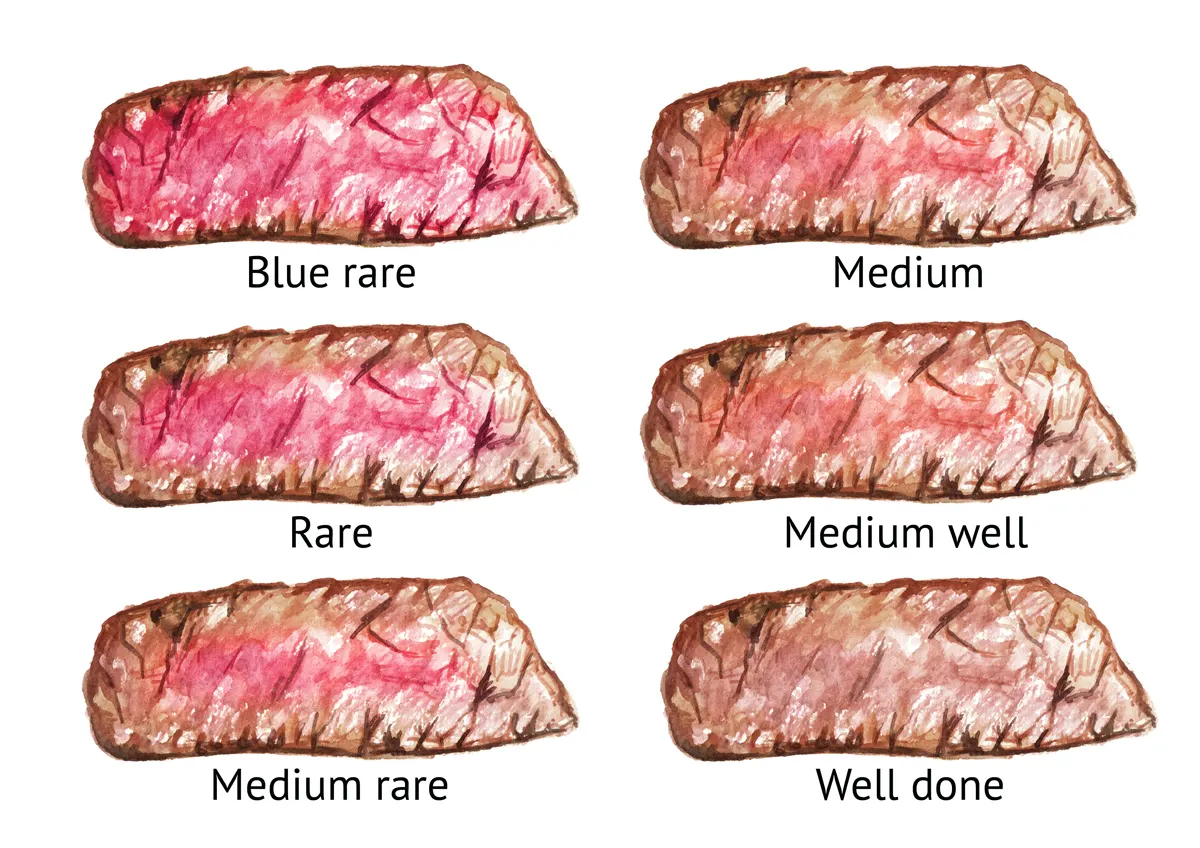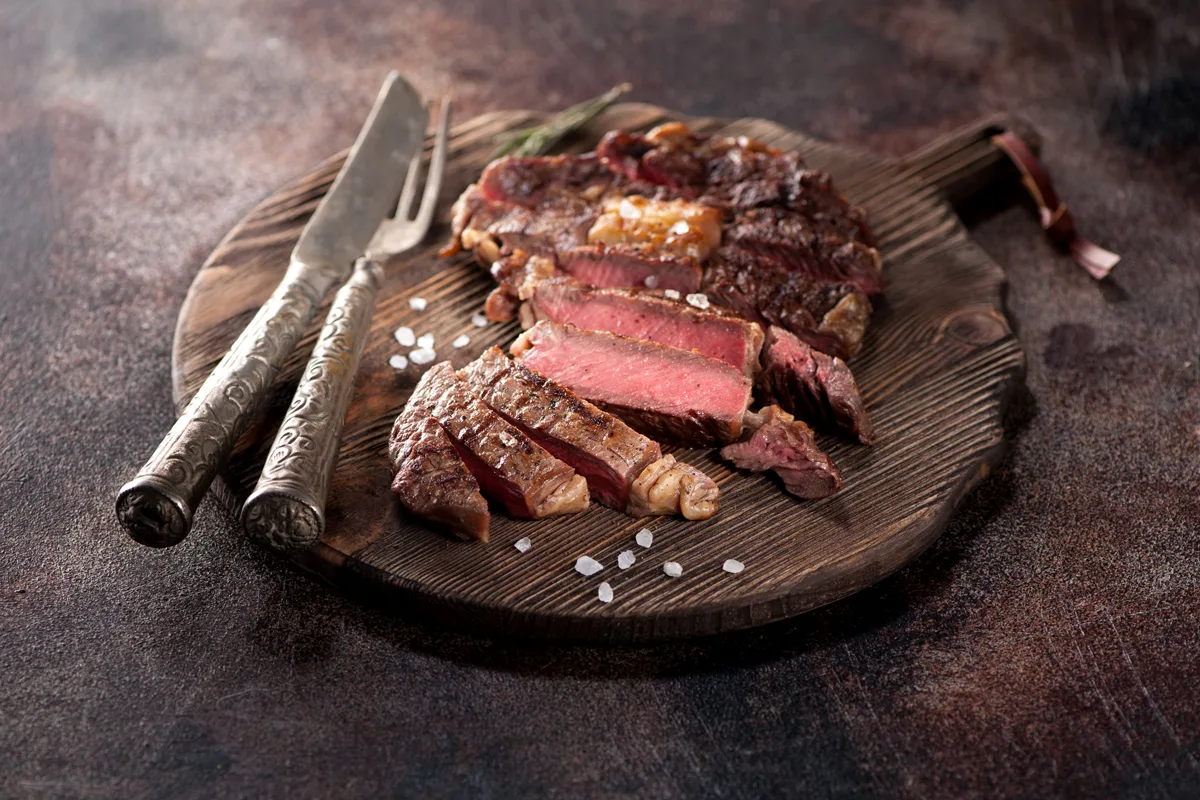Few things in this world compare to a perfectly cooked steak. They are meaty, juicy, moist, and full of beefy flavor.
Nevertheless, everybody has a specific temperature that they want their steaks to be cooked to.
Two of the most popular temperatures are medium and medium-rare.
As you can imagine, everyone believes their preferred steak temperature is the best steak temperature.
So it is no surprise that a medium vs. medium-rare debate has arisen.
Since this is an unusual debate, we must approach this debate differently by defining each temperature first.
Contents
What Is Medium?
Steaks cooked to medium feature a pink ring of meat sandwiched between 2 brownish greyish rings of meat.
The outside of the Denver steak is fully cooked and has a rich brown crust and a caramelized beefy flavor.
Medium steaks are considered the middle ground of steaks.
While they are not as juicy as other levels of doneness, medium steak juices will not spill all over your plate.
Additionally, medium steaks are not fully cooked and are still tender.
Furthermore, medium steaks have a soft yet slightly chewy texture.
What Is Medium Rare?
Medium-rare steaks are cooked for a shorter burst of time. Therefore medium-rare steaks are not exactly raw, but they are not as cooked as a medium-rare.
Medium-rare steaks are pink with a bit of red. You may hear the term slightly warmed when it comes to medium-rare meat.
Slightly warm simply refers to the red tinge of a medium-rare steak that is the same color as a raw steak.
What’s the Difference Between Medium and Medium-rare?
In short, medium-rare steak is cooked for less time than a medium steak. There are also differences in the color and texture of the steak.
For example, medium-rare steaks have a juicy texture and a light brown crust.
In contrast, medium steaks are not as pink as their counterparts. However, medium steaks are more tender.
Medium-cooked steak has much less pink and is more tender than juicy.
Is It Ok To Eat Slightly Raw Steak?
Beef is a different cut of meat. Most meats such as pork or poultry cannot be consumed raw. However, beef can.
This does not mean that you should consume every cut of beef raw.
Some cuts of beef, such as brisket or chuck roast, are way too tough to eat raw.
You would literally be chewing meat this as tough as rusty nails.
Cuts of beef such as a prime rib, burgers, or steaks can be consumed slightly raw.
In some people’s books, anything that’s not well done equals a raw steak.
While this is somewhat true, there is a difference between eating raw steak that has not come into contact with heat and cooked beef.
The USDA has recommended safe temperatures for consuming beef (we’ll discuss those later); therefore, it is ok to consume slightly raw steaks.
Nevertheless, you must still consider persons with compromised immune systems, such as children under 4 or the elderly, when cooking beef.
This is because their stomachs may not be equipped to handle raw meat.
Medium vs. Medium Rare
The medium vs. medium-rare debate is unlike any other discussion the steak world has seen.
Usually, steak enthusiasts will pit two cuts of steak, such as Ribeye or Tomahawk steak, against each other.
Nevertheless, we will compare these two steak temperatures in terms of temperature, cooking time, texture, juiciness, and color.
Temperature
Ultimately, if you want a medium Ranch steak, it needs to have an internal temperature of 135ºF-155ºF. In contrast, a medium-rare steak has a temperature between 130ºF-135ºF.
The best way to monitor a steak’s internal temperature is by using a food-grade thermometer. You can use a probe thermometer or an infrared thermometer.
Cooking Time
You can also use the cooking time to determine if the steak is cooked. However, the cooking time is not as reliable as the temperature.
For a medium steak, cook your ribeye steaks for approximately 3 minutes per side.
However, the cooking time may be shorter or longer depending on the thickness of the steak.
A steak that’s 1/2-inch in thickness will take less time to reach medium. On the other hand, a steak that’s 1 1/2 inches in thickness will take longer than 3 minutes to reach medium.
As I mentioned above, medium-rare steaks have shorter cooking times. Therefore, they only need 2 minutes per side to cook.
However, this cooking time may need to be adjusted depending on the thickness of the steak.
Texture
Essentially, the finger test is comparing the steaks’ texture to your hand’s texture. Simply press your thumb and ring finger together.
Feel the texture at the bottom of your thumb with your free hand. This texture is very similar to how a medium steak feels.
In contrast, you would pass your thumb and middle finger together when using the finger test methods for a medium-rare steak.
Feel the space around the base of your thumb. This resembles a medium-rare steak.
The finger test is the least accurate way of determining steak’s doneness. But it will help you know the difference in texture between a medium and medium-rare steak.
Remember, a medium-rare steak will be softer than a medium steak.
Medium-rare steaks are also softer and more tender than medium steaks. In contrast, medium steaks have a firm and chewy but still tender texture.
Medium-rare steaks will not have a rich dark brown crust as medium steaks do.
Juiciness
The longer a steak cooks, the more moisture it loses. Since medium-rare steaks are cooked less, they will have more moisture.
The added moisture also gives the medium-rare steak more flavor. Medium steaks are cooked longer, so they will not have as much moisture.
Color
In the same way, a steak will lose moisture the longer it cooks. A steak’s color will change from a bright red to a greyish brown color the longer it cooks.
Medium rare steaks should feel warm in the middle. When you cut a medium-rare steak open, it will reveal it will have a pink center with a red tinge.
The sides of a medium-rare steak will be browned, while the top and bottom crusts will have a rich brown color or grill marks depending on how it was cooked.
In contrast, when medium steaks are cut, they reveal a light pink center. However, the steak will be more brown than pink.
The sides of the steak should be browned. The top and bottom crusts of the steak should be charred but not black or burned.
Other Levels of Doneness for Steak
When it comes to steaks, there are six levels of doneness. We’ve already covered two levels of doneness (medium-rare and medium).
However, it’s important to mention the remaining levels of doneness, which include blue-rare, rare, medium-well, and well-done.
Remember, the internal temperature is the best determinant of the level of doneness.
The cooking time, color, and texture are not the best determinants of doneness.

Blue-rare
Blue-rare steak is dark, nearly purple in color. It is quickly seared, while the interior of the steak remains raw.
Therefore, blue-rare steaks are nearly warm. The internal temperature of a blue-rare steak is 115°F.
Rare
Rare steaks are cooked to a temperature between 120°F-130°F. Rare steaks are known for their red center and pinkish reddish band surrounding them.
The edges of the rare steak are slightly charred as they are cooked on a scorching hot natural gas grill or cast-iron skillet.
Since the fat will not have the chance to render, rare steaks are considered a lean cut of beef. Rare steaks are soft and very moist.
In fact, the juices released by rare steak remind some people of blood, which is why they prefer cooked more steaks.
Nevertheless, these blood-like juices are just myoglobin, a protein in the meats muscle fibers and water.
Medium-well
Medium-well steaks are cooked to a temperature of 155°F-164°F. Medium-well steaks are mostly cooked through with a tinge of pink.
Compared to their counterparts, medium-well steaks are less moist and flavorful since they are cooked longer.
Well-done
Well done, steaks are fully cooked with no pink in the center. They are firm to the touch. It takes about 10-12 minutes per side to cook.
A well-done steak will have a temperature of 170°F.
Additionally, you will have to cook the steak at a lower temperature as well as flip it over to prevent it from burning.
Is Medium-rare Better Than Medium Steak?
Whether r not medium-rare or medium is better depends on your preferred level of doneness. There’s no right or wrong level of doneness for steak.
You may prefer a firmer, tender medium steak with a slight amount of chew. In contrast, you may prefer a juicer medium-rare steak.
The only thing that matters is that the steak is cooked properly.
Final Thoughts
If you are just learning how to cook a steak, navigating the different levels of doneness can be difficult.
Everyone cooks a few bad steaks before they master how to cook the perfect steak.
Luckily now that you know the difference between medium and medium-rare steak, you can confidently grill up your steaks on your kamado grill.
You might also be interested in the following:

I have been smoking and grilling meat from an early age and enjoy sharing my knowledge and expertise through the hundreds of articles I have written about BBQ. I hope to make everyone’s BBQ journey that little bit easier.

